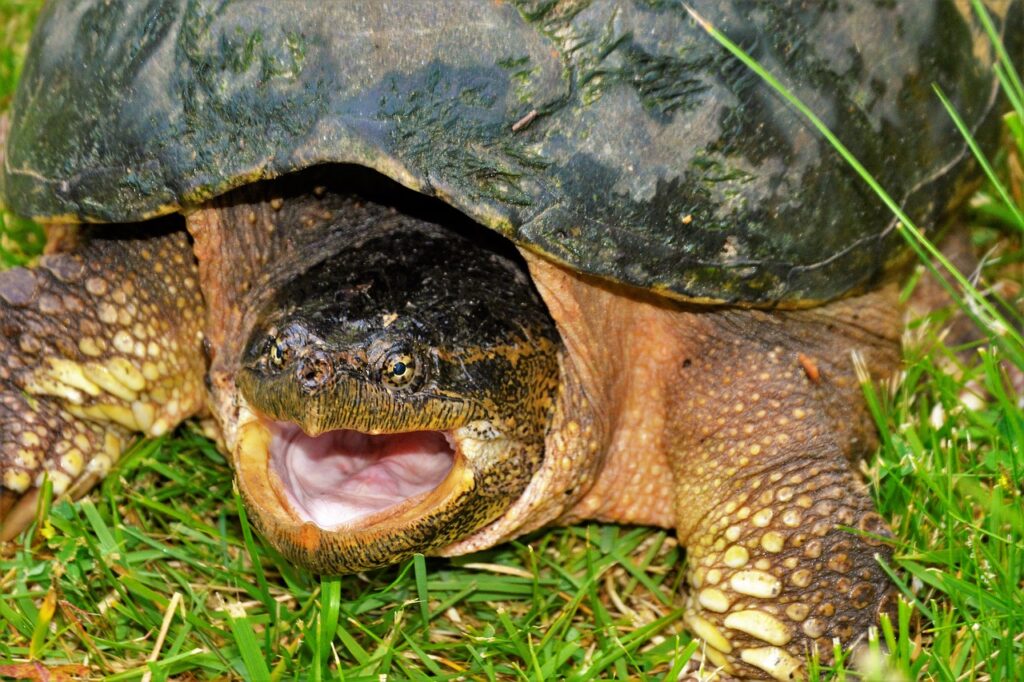Snapping turtles, often mistaken for docile creatures, can deliver a powerful and painful bite when provoked. These ancient reptiles are known for their distinctive appearance and unique behaviors. In this article, we will delve into the world of snapping turtles, explore the risks associated with their bites, and provide expert advice on how to avoid these potentially hazardous encounters.
The Snapping Turtle: A Fascinating Predator
Snapping turtles, scientifically known as Chelydra serpentina, are intriguing reptiles that can be found in freshwater habitats across North America. Known for their distinctive appearance, including a dark, bumpy shell and a long tail, these creatures have unique adaptations that make them formidable aquatic predators.
Anatomy and Behavior
- Jaws of Steel: The most remarkable feature of snapping turtles is their powerful jaws. They possess one of the strongest bites in the animal kingdom, capable of exerting immense pressure. The upper jaw has a sharp beak-like edge, while the lower jaw is serrated, allowing them to grip and consume prey effectively.
- Aquatic Ambush Predators: Snapping turtles are primarily aquatic and often lie in wait at the bottom of ponds, rivers, and swamps. They ambush their prey, which includes fish, amphibians, and even waterfowl. The element of surprise is crucial to their hunting strategy.
- Solitary Creatures: Snapping turtles are solitary animals and are rarely seen in groups. They are most active during the warmer months, especially during their breeding season.
The Dangers of Snapping Turtle Bites
While snapping turtles are generally not aggressive towards humans, they can bite when they feel threatened or cornered. Their bites can be painful and cause injuries, which is why it’s essential to understand the potential dangers associated with these reptiles.
Potential Injuries
- Painful Lacerations: Snapping turtle bites can result in painful lacerations due to their sharp beaks and serrated jaws. These wounds may require medical attention and could leave lasting scars.
- Risk of Infection: As with any animal bite, there is a risk of infection. Snapping turtles inhabit murky waters where bacteria thrive. This makes wound care and infection prevention vital.
- Complications: In severe cases, snapping turtle bites can lead to complications, including nerve or blood vessel damage. It’s crucial to seek immediate medical care if bitten.
Legal and Ethical Considerations
In many areas, snapping turtles are protected species. Harming or killing them can lead to legal repercussions. Ethical considerations also play a role in responsible wildlife interaction.
Expert Advice on Avoiding Snapping Turtle Bites
Preventing snapping turtle bites is key to ensuring a safe and harmonious coexistence with these unique reptiles. Here’s some expert advice on how to avoid encounters that may lead to bites.
1. Maintain a Respectful Distance
- Observation: If you come across a snapping turtle in the wild, observe from a distance. Do not attempt to handle or provoke the animal.
- Photography: Use a zoom lens for close-up shots. Never get too close for a selfie or a better view.
2. Caution Around Roadways
- Migratory Crossings: Snapping turtles are known to cross roads during their breeding season. Be vigilant when driving near water bodies, and if safe, assist them in crossing the road.
- Safe Handling: If you need to handle a snapping turtle to move it to safety, use caution. Wear gloves and support the turtle’s body properly, avoiding its head.
3. Keep Pets Leashed
- Leash Control: If you walk your dog near water, keep them on a leash. Dogs may be curious and provoke a snapping turtle, leading to potential bites.
- Avoid Disturbance: Teach your pets not to approach or harass turtles they encounter.
4. Educate and Inform Others
- Awareness: Share knowledge about snapping turtles and their behavior with friends and family. The more people know, the better they can avoid unnecessary encounters.
- Public Safety: Advocate for proper signage and protective measures in areas where snapping turtles are known to inhabit.
5. Children’s Education
- Teach Caution: Educate children about the importance of respecting wildlife and avoiding contact with snapping turtles.
- Supervision: Always supervise children when they are near water where snapping turtles may be present.
6. Reporting Injured Turtles
- Contact Authorities: If you come across an injured or distressed snapping turtle, contact local wildlife authorities or rescue organizations for assistance.
- Non-Interference: Do not attempt to rehabilitate or handle injured turtles without proper knowledge and guidance.
Conclusion
Snapping turtles are intriguing creatures that play a vital role in aquatic ecosystems. While their bites can be painful and potentially dangerous, with the right knowledge and precautions, you can safely coexist with these unique reptiles. By maintaining a respectful distance, understanding their behavior, and educating others, we can reduce the risk of snapping turtle bites and help protect these important members of our ecosystem. Remember, appreciation and responsible interaction with wildlife go hand in hand.
